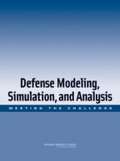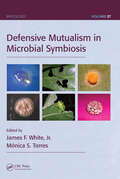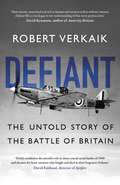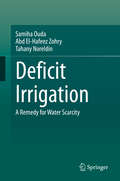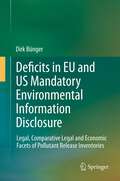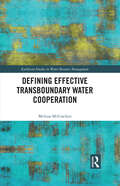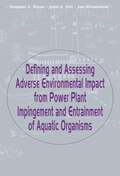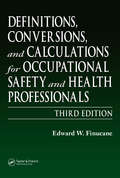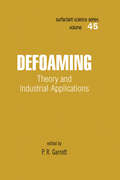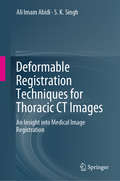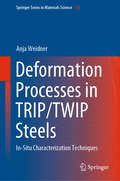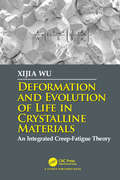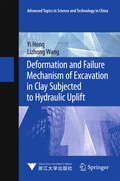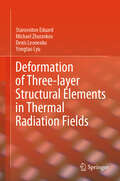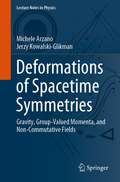- Table View
- List View
Defense Modeling, Simulation, and Analysis: MEETING THE CHALLENGE
by National Research Council of the National AcademiesModeling, simulation, and analysis (MS&A) is a crucial tool for military affairs. MS&A is one of the announced pillars of a strategy for transforming the U.S. military. Yet changes in the enterprise of MS&A have not kept pace with the new demands arising from rapid changes in DOD processes and missions or with the rapid changes in the technology available to meet those demands. To help address those concerns, DOD asked the NRC to identify shortcomings in current practice of MS&A and suggest where and how they should be resolved. This report provides an assessment of the changing mission of DOD and environment in which it must operate, an identification of high-level opportunities for MS&A research to address the expanded mission, approaches for improving the interface between MS&A practitioners and decision makers, a discussion of training and continuing education of MS&A practitioners, and an examination of the need for coordinated military science research to support MS&A.
Defense Resource Planning Under Uncertainty
by Robert J. Lempert Robert W. Button Kate Giglio Ryan Henry Jonathan Klenk Drake WarrenDefense planning faces significant uncertainties. This report applies robust decision making (RDM) to the air-delivered munitions mix challenge. RDM is quantitative, decision support methodology designed to inform decisions under conditions of deep uncertainty and complexity. This proof-of-concept demonstration suggests that RDM could help defense planners make plans more robust to a wide range of hard-to-predict futures.
Defense and Recognition in the Climate Crisis: How to Communicate About Truths, Facts and Opinions
by Barbara StrohscheinTruths, facts and opinions on the climate issue are often met with psychological or social defense, both publicly and privately. Based on selected psychological and philosophical theories as well as data material, this book shows how defense comes about, how it works, and how, on the other hand, the necessary recognition can succeed on various levels. It is only through recognition that constructive discourse becomes possible. This book offers all the basics to be able to theoretically and practically solve communication conflicts between defense and recognition in the climate crisis.
Defensive Mutualism in Microbial Symbiosis (Mycology)
by James F. White Jr. Mónica S. TorresAnemones and fish, ants and acacia trees, fungus and trees, buffaloes and oxpeckers--each of these unlikely duos is an inimitable partnership in which the species' coexistence is mutually beneficial. More specifically, they represent examples of defensive mutualism, when one species receives protection against predators or parasites in exchange for
Defensive Tactics for Today’s Law Enforcement
by Stephen K. Hayes Joe NiehausFew of the many defensive tactics books on the market include the training and methods of martial arts. Drawing on the centuries-old techniques of Ninjutsu, Defensive Tactics for Today’s Law Enforcement offers alternatives to the traditional police defensive tactics taught to most officers. This text stresses relying on natural tendencies in a violent encounter to ensure officer safety and to better utilize the techniques and training officers do receive. By integrating existing training with martial arts expertise, Defensive Tactics provides officers access a full complement of techniques to better navigate physical conflict safely and effectively. Intended for law enforcement practitioners, as well as practitioners of any other professions that present a personal security risk, Defensive Tactics for Today’s Law Enforcement will better equip readers with a diverse range of defensive tactics.
Deferring Development: Setting Aside Cells for Future Use in Development and Evolution (Evolutionary Cell Biology)
by Brian K. Hall Cory Douglas BishopThis volume examines cells set aside during development for use later in ontogeny or in adult life. There is no single term for such cells. The cells explored fall within several major categories — stem cells, set-aside cells (in echinoderm larvae), imaginal discs in insects such as Drosophila, meristems (plants), blastemata (regeneration in amphibians), neoblasts (regeneration in planarians). The book compares and contrasts these cell types and the environments (niches) in which they operate with the aim of unravelling any relationships between them, between their activation in development, and in their evolution. Key Features Explores the nature of deferred-use cells in evolutionary and developmental context. Reviews the mechanisms of development of set-aside cells, such as stem cells, meristems, and imaginal discs. Provides phylogenetic overview of different types of deferred-use cells. Compares and contrasts different theories on the origin of deferred-use cells. Related Titles Calegari, F. & C. Waskow, eds. Stem Cells: From Basic Research to Therapy (ISBN 978-1-4822-0775-0) Cabral, J. M. S. & C. L. da Silva, eds. Bioreactors for Stem Cell Expansion and Differentiation (ISBN 978-1-4987-9590-6) Kong, H., A. J. Putnam, & L. B. Schook, eds. Stem Cells and Revascularization Therapies (ISBN 978-1-4398-0323-3) Schaffer, D., J. D. Bronzino, & D. R. Peterson, eds. Stem Cell Engineering: Principles and Practices (ISBN 978-1-4398-7204-8)
Defiant: The Untold Story of the Battle of Britain
by Robert Verkaik'Defiant is both a stirring testament to the courage of the men who flew them and a welcome new examination of one of the Second World War's most famous conflicts'Alexander Larman, ObserverIn this startling new perspective on the Battle of Britain, Robert Verkaik reveals the surprising truth about the battle's forgotten fighter, the Boulton Paul Defiant.The crucial role played by the Spitfire and the Hurricane has been exhaustively recorded, but, to date, next to nothing has been written about the third British fighter which took part in the battle. By writing from the unique perspective of the pilots who flew the Defiant and their air-gunners, Verkaik helps to set the record straight. The Air Staff regarded the Defiant as a state-of-the-art bomber destroyer and wanted to equip a third of all Fighter Command squadrons with this new plane. But the head of Fighter Command, Hugh Dowding, had other ideas and went to war with Whitehall over its plan to saddle him with hundreds of 'obsolete' turret fighters. Then at Dunkirk, a Defiant squadron scored a huge success against the Luftwaffe by shooting down more German planes in one day than any other RAF unit before or since. Fighter Command, enthusiastically urged on by the Air Ministry, now committed its third fighter to the coming air battle over southern England. In the desperate dogfights of the battle, Defiants shot down both German bombers and fighters but suffered heavy losses too - one squadron was almost wiped out when it was ambushed by a superior force of Messerschmitt 109s. On 30 August 1940 all Defiant squadrons were withdrawn from the front line. The families of the Defiant air crews believed that their husbands, brothers and sons had died in vain, but the truth is that their vital contribution to the battle over Dunkirk and their role in the Battle of Britain has been all but erased from the official history. The story of the Defiant has not been allowed to mar the glorious victory won by the Spitfire and the Hurricane.But Verkaik has uncovered new records, including top-secret memos written by Hugh Dowding and his deputy Keith Park as well as correspondence with the Air Staff, combat and squadron reports, pilot logs and recordings of the last interviews with Defiant crews. He has also succeeded in tracing relatives of Defiant pilots and gunners to tell the story of the Battle of Britain as it has never been told before. He reveals how the myths which have grown up around the Defiant mask some inconvenient truths.
Deficit Irrigation: A Remedy for Water Scarcity
by Samiha Ouda Tahany Noreldin Abd El-Hafeez ZohryThis book focuses on proving that deficit irrigation could play an important role in increasing food production in times of water scarcity. Although the application of deficit irrigation can involve loss in crop productivity, it still secures water to be use in cultivating more lands and producing more food. The following questions are discussed and the authors offer solutions to these problems:Will the production, on a national level, resulting from these new added areas compensate yield losses attained by application of deficit irrigation?Is it possible to use deficit irrigation practice to reduce the applied irrigation water to certain crops that have a surplus in their production, and direct this saved water to cultivate new areas with crops have low self-sufficiency ratios? Under climate change in 2030, would deficit irrigation practice have the same role it plays under the current conditions? This book will appeal to students and researchers involved with water scarcity and food security.
Deficits in EU and US Mandatory Environmental Information Disclosure
by Dirk BüngerIt is the publicity about the Pollutant Release Inventory's data which creates an incentive for firms to achieve emission reductions. Accordingly, public access to environmental information constitutes a core characteristic of the aforementioned inventory. Here, in essence, two facets arise. First, with regard to the collection, it is disputed whether such information, which may comprise confidential commercial and industrial information in the EU as well as trade secrets in the US, can be protected under fundamental and constitutional property rights respectively. Second, in the context of dissemination and utilisation, it is arguable whether the information indeed impacts polluters and produces an outcome that secures a certain level of environmental protection. The author responds to the first issue by taking the EU and US jurisdictions into account and strives to analyse how this novel form of Internet disclosure liberates market mechanisms in the quest for effective and efficient emission reductions.
Defining Effective Transboundary Water Cooperation (Earthscan Studies in Water Resource Management)
by Melissa McCrackenThis book establishes a framework for defining transboundary water cooperation and a methodology for evaluating its effectiveness, which will contribute to more effective and therefore successful cooperation processes. With the increasing focus on transboundary cooperation as a part of the Sustainable Development Goal Framework, there is global recognition of transboundary water cooperation as a tool for improved governance and management of transboundary surface and groundwaters. However, there is not an agreed upon definition of transboundary water cooperation in the literature or in practice. This book develops the Four Frames of Transboundary Water Cooperation, which is a neutral modular framework for developing context-specific explanatory definitions of transboundary water cooperation in basins and aquifers. The Four Frames of Cooperation are legal, institutional, relational, and outcome. However, we need to move beyond defining cooperation to understand better measures of the quality and effectiveness of cooperative processes. The Weighted Model of Effective Cooperation presents a first step in qualitatively evaluating the effectiveness of transboundary water cooperation. This model defines effective transboundary water cooperation and operationalizes a method to evaluate the effectiveness of cooperative processes over internationally shared waters. Effective cooperation emphasizes the relational and outcome frames of cooperation while working towards equitability and sustainability. Together, the Four Frames of Cooperation and the Weighted Model of Effective Cooperation will improve the understanding of cooperation and encourage a detailed evaluation of the quality, success, and effectiveness of cooperative processes. This book will be of great interest to students and scholars of water resource management, water governance, and environmental politics. It will also appeal to policymakers and professionals working in the fields of water conflict, water diplomacy, and international cooperation.
Defining Nature's Limits: The Roman Inquisition and the Boundaries of Science
by Neil TarrantA look at the history of censorship, science, and magic from the Middle Ages to the post-Reformation era. Neil Tarrant challenges conventional thinking by looking at the longer history of censorship, considering a five-hundred-year continuity of goals and methods stretching from the late eleventh century to well into the sixteenth. Unlike earlier studies, Defining Nature’s Limits engages the history of both learned and popular magic. Tarrant explains how the church developed a program that sought to codify what was proper belief through confession, inquisition, and punishment and prosecuted what they considered superstition or heresy that stretched beyond the boundaries of religion. These efforts were continued by the Roman Inquisition, established in 1542. Although it was designed primarily to combat Protestantism, from the outset the new institution investigated both practitioners of “illicit” magic and inquiries into natural philosophy, delegitimizing certain practices and thus shaping the development of early modern science. Describing the dynamics of censorship that continued well into the post-Reformation era, Defining Nature's Limits is revisionist history that will interest scholars of the history science, the history of magic, and the history of the church alike.
Defining Nature's Limits: The Roman Inquisition and the Boundaries of Science
by Neil TarrantA look at the history of censorship, science, and magic from the Middle Ages to the post-Reformation era. Neil Tarrant challenges conventional thinking by looking at the longer history of censorship, considering a five-hundred-year continuity of goals and methods stretching from the late eleventh century to well into the sixteenth. Unlike earlier studies, Defining Nature’s Limits engages the history of both learned and popular magic. Tarrant explains how the church developed a program that sought to codify what was proper belief through confession, inquisition, and punishment and prosecuted what they considered superstition or heresy that stretched beyond the boundaries of religion. These efforts were continued by the Roman Inquisition, established in 1542. Although it was designed primarily to combat Protestantism, from the outset the new institution investigated both practitioners of “illicit” magic and inquiries into natural philosophy, delegitimizing certain practices and thus shaping the development of early modern science. Describing the dynamics of censorship that continued well into the post-Reformation era, Defining Nature's Limits is revisionist history that will interest scholars of the history science, the history of magic, and the history of the church alike.
Defining and Assessing Adverse Environmental Impact from Power Plant Impingement and Entrainment of Aquatic Organisms: Symposium in Conjunction with the Annual Meeting of the American Fisheries Society, 2001, in Phoenix, Arizona, USA
by Joe Wisniewski Douglas A. Dixon John A. VeilThe U.S. Clean Water Act calls for the minimization of "adverse environmental impact" at cooling water intake structures. To facilitate an exchange of information among all stakeholders in the issue, the Electric Power Research Institute organised a national symposium in 2001 to discuss the meaning of adverse environmental impact and methods
Defining the Wind: The Beaufort Scale, and How a 19th-century Admiral Turned Science into Poetry
by Scott HulerA remarkable journey over land and sea into a fascinating world of explorers, mariners, scientists, and writers. Huler was so taken with the Beaufort Wind Scale that he went in search of Adm. Francis Beaufort himself: hydrographer to the British Admiralty, man of science, and author -- Huler assumed -- of the Beaufort Wind Scale. But the scale that carries Beaufort's name has a long and complex evolution, and to properly understand it means reaching farther back in history, into the lives and works of figures from Daniel Defoe and Charles Darwin to Captains Bligh and Cook. All around the world in the mid-18th and 19th century, modern science was being invented every day. A wonderfully readable story that is ultimately about how we observe the forces of nature and the world around us.
Definition Of Pain And Distress And Reporting Requirements For Laboratory Animals: Proceedings Of The Workshop Held June 22, 2000
by Committee on Regulatory Issues in Animal Care UseA report on the Definition Of Pain And Distress And Reporting Requirements For Laboratory Animals
Definitions and Mathematical Knowledge (Elements in the Philosophy of Mathematics)
by Andrea SereniThis Element discusses the philosophical roles of definitions in the attainment of mathematical knowledge. It first focuses on the role of definitions in foundational programs, and then examines their major varieties, both as regards their origins, their potential epistemic roles, and their formal constraints. It examines explicit definitions, implicit definitions, and implicit definitions of primitive terms, these latter being further divided into axiomatic and abstractive. After discussing elucidations and explications, various ways in which definitions can yield mathematical knowledge are surveyed.
Definitions, Conversions, and Calculations for Occupational Safety and Health Professionals
by Edward W. FinucaneStanding firmly on the foundation built by the previous two editions, each a bestseller in its own right, Definitions, Conversions, and Calculations for Occupational Safety and Health Professionals, Third Edition is bound to repeat this success. A multipurpose reference suitable for professionals throughout the field, the book contains virtually ev
Defoaming: Theory and Industrial Applications (Surfactant Science #45)
by P R. GarrettReviews all known antifoam mechanisms, and discusses the appropriate practical approaches for solving foam control problems in a variety of industrial contexts. These range from crude oil production to detergent formulation.
Deformable Registration Techniques for Thoracic CT Images: An Insight into Medical Image Registration
by Ali Imam Abidi S.K. SinghThis book focuses on novel approaches for thoracic computed tomography (CT) image registration and determination of respiratory motion models in a range of patient scenarios. It discusses the use of image registration processes to remove the inconsistencies between medical images acquired using different devices. In the context of comparative research and medical analysis, these methods are of immense value in image registration procedures, not just for thoracic CT images, but for all types of medical images in multiple modalities, and also in establishing a mean respiration motion model. Combined with advanced techniques, the methods proposed have the potential to advance the field of computer vision and help improve existing methods. The book is a valuable resource for those in the scientific community involved in modeling respiratory motion for a large number of people.
Deformation Processes in TRIP/TWIP Steels: In-Situ Characterization Techniques (Springer Series in Materials Science #295)
by Anja WeidnerThis book demonstrates the potential of novel in-situ experiments, performed on microscopic and macroscopic length scales, for investigating localized deformation processes in metallic materials, particularly their kinetics and the associated evolution of local strain fields. It features a broad methodological portfolio, spanning optical and electron microscopy, digital image correlation, infrared theromgraphy and acoustic emission testing, and particularly focuses on identifying the localized microscopic deformation processes in high-strength/high-ductility CrMnNi TRIP/TWIP (TRansformation Induced Plasticity/TWinning Induced Plasticity) steels. Presenting state-of-the art methodology applied to topical and pertinent problems in materials engineering, this book is a valuable resource for researchers and graduate students working in the field of plasticity and deformation of structural materials.
Deformation and Evolution of Life in Crystalline Materials: An Integrated Creep-Fatigue Theory
by Xijia WuThis book walks you through the fundamental deformation and damage mechanisms. It lends the reader the key to open the doors into the maze of deformation/fracture phenomena under various loading conditions. Furthermore it provides the solution method to material engineering design and analysis problems, for those working in the aerospace, automotive or energy industries. The book introduces the integrated creep-fatigue theory (ICFT) that considers holistic damage evolution from surface/subsurface crack nucleation to propagation in coalescence with internally-distributed damage/discontinuities.
Deformation and Failure Mechanism of Excavation in Clay Subjected to Hydraulic Uplift
by Yi Hong Lizhong WangThis book presents the latest experimental and numerical analysis work in the field of ground deformation and base instability of deep excavations in soft clay subjected to hydraulic uplift. The authors' latest research findings, based on dimensional analyses, well-instrumented full-scale field tests, systematic coupled-consolidation finite element analyses and centrifuge tests are reported. This book shows how to systematically approach a complex geotechnical problem, from identifying existing problems, reviewing literature, to dimensional and numerical analyses, validation through full-scale testing and centrifuge model testing. The methodologies are also introduced as major tools adopted in geotechnical research.
Deformation of Three-layer Structural Elements in Thermal Radiation Fields
by Yongtao Lyu Michael Zhuravkov Starovoitov Eduard Denis LeonenkoThis book methodically details the formulations and approaches to solve boundary value problems, which are essential for determining the stress–strain states in three-layer rods and plates subjected to both single and quasi-static variable loads in thermal radiation and force fields. It duly considers the complex influences on the physically nonlinear properties of the materials in each layer. The book offers several innovative analytical solutions and a numerical parametric analysis of the stress–strain scenarios in these structures. It describes the deformation of physically nonlinear media in thermoradiational fields within the small elastic-plastic deformations theory framework. The work explores variational problem-solving methods and the elastic solution method. It presents a formula for calculating the temperature within a three-layer assembly, derived by averaging the thermophysical properties of the materials across the layers' thickness. Additionally, the book includes an analysis of the attenuation of neutron flux as it passes through a three-layer element.
Deformations of Spacetime Symmetries: Gravity, Group-Valued Momenta, and Non-Commutative Fields (Lecture Notes in Physics #986)
by Michele Arzano Jerzy Kowalski-GlikmanThis monograph provides an introduction to deformations of Poincaré symmetries focusing on models with a Lie group momentum space and associated non-commutative space-times. The emphasis is put on the emergence of such structures from quantum gravity, their mathematical features described in terms of Hopf algebras and applications to particle kinematics and field theory. Part I of this work focuses on the link between gravity and deformed symmetries in the case of 2+1 and 3+1 space-time dimensions. Part II is devoted to the description of classical particles with group valued momenta, their phase spaces and kinematics. The last part of these notes provides an introduction to the basic features of classical and quantum field theory on κ-Minkowski space-time, the prototypical example of non-commutative space-time exhibiting deformed Poincaré symmetry. The text, being the first providing a detailed overview of these topics, is primarily intended for researchers and graduate students interested in non-commutative field theories and quantum gravity phenomenology.
Defrosting Ancient Microbes: Emerging Genomes in a Warmer World
by John D. Castello Scott RogersIce is melting around the world and glaciers are disappearing. Water, which has been solid for thousands and even millions of years, is being released into streams, rivers, lakes and oceans. Embedded in this new fluid water, and now being released, are ancient microbes whose effects on today's organisms and ecosystems is unknown and unpredictable. These long sleeping microbes are becoming physiologically active and may accelerate global climate change. This book explores the emergence of these microbes. The implications for terrestrial life and the life that might exist elsewhere in the universe are explored. Key Selling Points: Explores the role of long frozen ancient microbes will have when released due to global warming Describes how ice preserves microbes and microbial genomes for thousands or millions of years Reviews work done on permafrost microbiology Identifies potential health hazards and environmental risks Examines implications for the search for extraterrestrial life.
